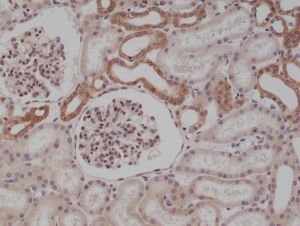
Immunohistochemical staining of formalin fixed and paraffin embedded human kidney tissue section using anti-MyD88 rabbit monoclonal antibody (Clone RM306) at a 1:250 dilution.
anti-MYD88 (human), Rabbit Monoclonal (RM306)
REV-31-1192-00
ApplicationsWestern Blot, ImmunoHistoChemistry
Product group Antibodies
ReactivityHuman
TargetMYD88
Overview
- SupplierRevMAb Biosciences
- Product Nameanti-MYD88 (human), Rabbit Monoclonal (RM306)
- Delivery Days Customer10
- ApplicationsWestern Blot, ImmunoHistoChemistry
- CertificationResearch Use Only
- ClonalityMonoclonal
- Clone IDRM306
- Gene ID4615
- Target nameMYD88
- Target descriptionMYD88 innate immune signal transduction adaptor
- Target synonymsIMD68, MYD88D, WM1, myeloid differentiation primary response protein MyD88, TLR adaptor MYD88, mutant myeloid differentiation primary response 88, myeloid differentiation primary response 88, myeloid differentiation primary response gene (88)
- HostRabbit
- IsotypeIgG
- Protein IDQ99836
- Protein NameMyeloid differentiation primary response protein MyD88
- Scientific DescriptionRecombinant Antibody. This antibody reacts to human myeloid differentiation primary response protein MyD88. Applications: WB, IHC. Source: Rabbit. Liquid. 50% Glycerol/PBS with 1% BSA and 0.09% sodium azide. TLRs recognize conserved motifs found in various pathogens and mediate defense responses. Triggering of the TLR pathway leads to the activation of NF-kappaB and subsequent regulation of immune and inflammatory genes. The TLRs and members of the IL-1 receptor family share a conserved stretch of approximately 200 amino acids known as the Toll/Interleukin-1 receptor (TIR) domain. Upon activation, TLRs associate with a number of cytoplasmic adaptor proteins containing TIR domains, including myeloid differentiation factor 88 (MyD88), MyD88-adaptor-like/TIR-associated protein (MAL/TIRAP), Toll-receptor-associated activator of interferon (TRIF) and Toll-receptor-associated molecule (TRAM). This association leads to the recruitment and activation of IRAK1 and IRAK4, which form a complex with TRAF6 to activate TAK1 and IKK. Activation of IKK leads to the degradation of IkappaB, which normally maintains NF-kappaB in an inactive state by sequestering it in the cytoplasm. MyD88 was originally isolated as a myeloid differentiation primary response gene that is rapidly induced upon IL-6 stimulated differentiation of M1 myeloleukemic cells into macrophages. It contains an amino-terminal death domain separated from a carboxyl-terminal TIR domain and functions as an adaptor in TLR/IL-1 receptor signaling. The death domain of MyD88 mediates interactions with the IRAK complex triggering a signaling cascade that includes the activation of NF-kappaB. - TLRs recognize conserved motifs found in various pathogens and mediate defense responses. Triggering of the TLR pathway leads to the activation of NF-kappaB and subsequent regulation of immune and inflammatory genes. The TLRs and members of the IL-1 receptor family share a conserved stretch of approximately 200 amino acids known as the Toll/Interleukin-1 receptor (TIR) domain. Upon activation, TLRs associate with a number of cytoplasmic adaptor proteins containing TIR domains, including myeloid differentiation factor 88 (MyD88), MyD88-adaptor-like/TIR-associated protein (MAL/TIRAP), Toll-receptor-associated activator of interferon (TRIF) and Toll-receptor-associated molecule (TRAM). This association leads to the recruitment and activation of IRAK1 and IRAK4, which form a complex with TRAF6 to activate TAK1 and IKK. Activation of IKK leads to the degradation of IkappaB, which normally maintains NF-kappaB in an inactive state by sequestering it in the cytoplasm. MyD88 was originally isolated as a myeloid differentiation primary response gene that is rapidly induced upon IL-6 stimulated differentiation of M1 myeloleukemic cells into macrophages. It contains an amino-terminal death domain separated from a carboxyl-terminal TIR domain and functions as an adaptor in TLR/IL-1 receptor signaling. The death domain of MyD88 mediates interactions with the IRAK complex triggering a signaling cascade that includes the activation of NF-kappaB.
- ReactivityHuman
- Storage Instruction-20°C
- UNSPSC12352203






